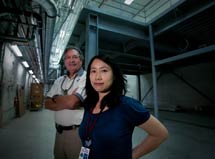
Handy Links
SLAC News Center
SLAC Today
- Subscribe
- Archives: Feb 2006-May 20, 2011
- Archives: May 23, 2011 and later
- Submit Feedback or Story Ideas
- About SLAC Today
SLAC News
Lab News
- Interactions
- Lightsources.org
- ILC NewsLine
- Int'l Science Grid This Week
- Fermilab Today
- Berkeley Lab News
- @brookhaven TODAY
- DOE Pulse
- CERN Courier
- DESY inForm
- US / LHC
SLAC Links
- Emergency
- Safety
- Policy Repository
- Site Entry Form

- Site Maps
- M & O Review
- Computing Status & Calendar
- SLAC Colloquium
- SLACspeak
- SLACspace
- SLAC Logo
- Café Menu
- Flea Market
- Web E-mail
- Marguerite Shuttle
- Discount Commuter Passes
-
Award Reporting Form
- SPIRES
- SciDoc
- Activity Groups
- Library
Stanford
Around the Bay
Where the LCLS Ends: The MEC Instrument
The sixth and final instrument currently planned for the Linac Coherent Light Source will investigate the extremes of the universe around us. The Matter in Extreme Conditions instrument, supported by DOE Office of Science Recovery Act funds, will allow researchers to create and probe matter at extreme temperatures, extreme pressures and extreme densities. The instrument is slated for completion in 2013.
"With the MEC, we will study novel states of matter," said MEC Instrument Scientist Hae Ja Lee, who joined the SLAC team last month after spending three and a half years studying matter in extreme conditions at UC Berkeley. "The instrument offers us the opportunity to perform some of the most detailed measurements of matter under extreme conditions ever made."
Much like the X-ray Pump Probe instrument, the MEC will use an optical laser beam, and at times the LCLS itself, to initiate a reaction or prepare an initial excited state in a sample. The LCLS X-ray beam will then probe how the reaction takes place or how the sample relaxes out of its excited state.
Though the MEC's general set-up will be similar to XPP, the two instruments will probe matter in very different states. "With the XPP, researchers will look at matter with a solid density and at room temperature," said Jerry Hastings, head of the LCLS X-ray Science Department. "With MEC, we're far from those conditions."
Using powerful optical lasers and the LCLS's ultra-bright, ultra-short X-ray pulses, the MEC will have the unique capability of creating and probing the short-lived states of matter that can exist during inertial fusion processes, in the cores of giant planets and inside supernovae. Matter passing through such transient states may also be the precursor for new types of materials that have yet to be discovered.
For example the MEC high energy laser might be used to create high pressure states that can substantially exceed 1 megabar—about 1000 times atmospheric pressure . The LCLS beam could then reveal the exceedingly small (nanoscale) and rapid (less than 100 femtoseconds) modifications of the matter’s thermodynamic properties and structure.
"The combination of the instrument's laser systems together with the LCLS beam gives us the ability to create and probe novel conditions and unusual states of matter," said Hastings. "Studying them experimentally has been nearly impossible in the past, and theoretical treatment is so complex as to be unreliable. The MEC will allow us to answer fundamental questions about these extreme states of matter."
This story is the fifth in a series series exploring the scientific instruments of the LCLS. See also "The CXI Instrument," "The AMO Instrument," "The XPP Instrument" and "The XCS Instrument."
—Kelen Tuttle
SLAC Today, September 1, 2009
